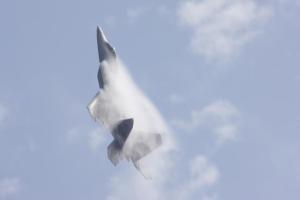You’ll recall the Air Force claims its F-22 fighter is the world’s best. Heck, at $350 million a pop, it should be. Too bad they didn’t invest in RustOleum when they were building it.
 The Government Accountability Office reports:
The Government Accountability Office reports:
Corrosion of the aluminum skin panels on the F-22 was first observed in spring 2005, less than 6 months after the Air Force first introduced the aircraft to a severe environment. By October 2007, a total of 534 instances of corrosion were documented, and corrosion in the substructure was becoming prevalent. For corrosion damage identified to date, the government is paying $228 million to make F-22 corrosion-related repairs and retrofits through 2016.
That’s $228 million for 187 planes, or more than $1 million a plane to fix something on what is essentially a brand new aircraft (and yes, despite the headline, we know corrosion and rust aren’t synonymous). Bet you’re wondering how this screw-up happened. Well, for starters, note the government — surprise! — is footing the bill.
The GAO goes on to say that the plane was designed with a “performance-based acquisition approach” that “gives the contractor the flexibility to design the aircraft to meet high-level requirements set by the government.” But those Air Force wizards dictating the plane’s design neglected to add a “corrosion prevention user requirement.” Instead, the F-22 “only required `corrosion resistance’ within the system specifications, a poorly defined and nonspecific term that is difficult to ensure incorporation into aircraft components and to verify.” It’s the same old story: complex contracts cow contractors into performing precisely as prescribed, with scant attention paid by world-class engineers to real-world problems. Like weather.
The GAO also notes that:
–No operational-level test for corrosion was conducted on the F-22 prior to initial operating capability…
— The length of the F-22 full-scale climatic test was cut in half…
— …If the F-22 program had accomplished testing earlier in the program, many of the corrosion problems could have been addressed at greatly reduced cost and the associated readiness issues avoided.
Well, $350 million can’t cover everything.
But not to worry: “The Air Force is strengthening the charter of the Air Force Corrosion Prevention Advisory Board to, among other things, include other stakeholders,” the GAO says, “and forming integrated product teams within the Advisory Board to address corrosion-related weaknesses.”


